

We weren't the only shoppers at
Behnke's; the great weather and Mother's Day combined to fill the parking lot. I am always impressed at the variety and quality of the perennials at Behnke's. They have a great selection of woody plants too, they're in good shape, and the prices are pretty good. No true Nursery or Garden Center is going to be able to match Box Store prices across the board, but no Box Store will have the breadth of selection or a staff with the knowledge and experience that a Nursery/Garden Center can supply.
If you click on the receipt, it becomes larger and legible. The 10 "steppables" include five Pink Pussytoes and five low Thymes. Unidentified annuals include Petunias and Cosmos. The courtyard is quite hot, actually it bakes, because of the masonry that defines it, so Dianthus, Salvia, the Broom, the Lavenders, Thymes, and Antennaria should all be very happy. It seems that the first incarnation of the garden had it as a classic shade garden with Dogwoods, Azaleas, Hostas, et alia. It's just too hot. The Dogwoods are working, and some shaded Azaleas are okay, but I'm gradually removing most of the Azaleas and most of the Hostas. Its going to become something approaching a Mediterranean garden...right in my wheelhouse!
If you're interested in seeing any of these plants in the ground, they will, of course, be planted in the Courtyard Garden at the Beltsville Library. There will be an Open House on Saturday May 23 starting at 11:00 am where I will be happy to discuss these or any plants or anything horticultural or botanical!




































